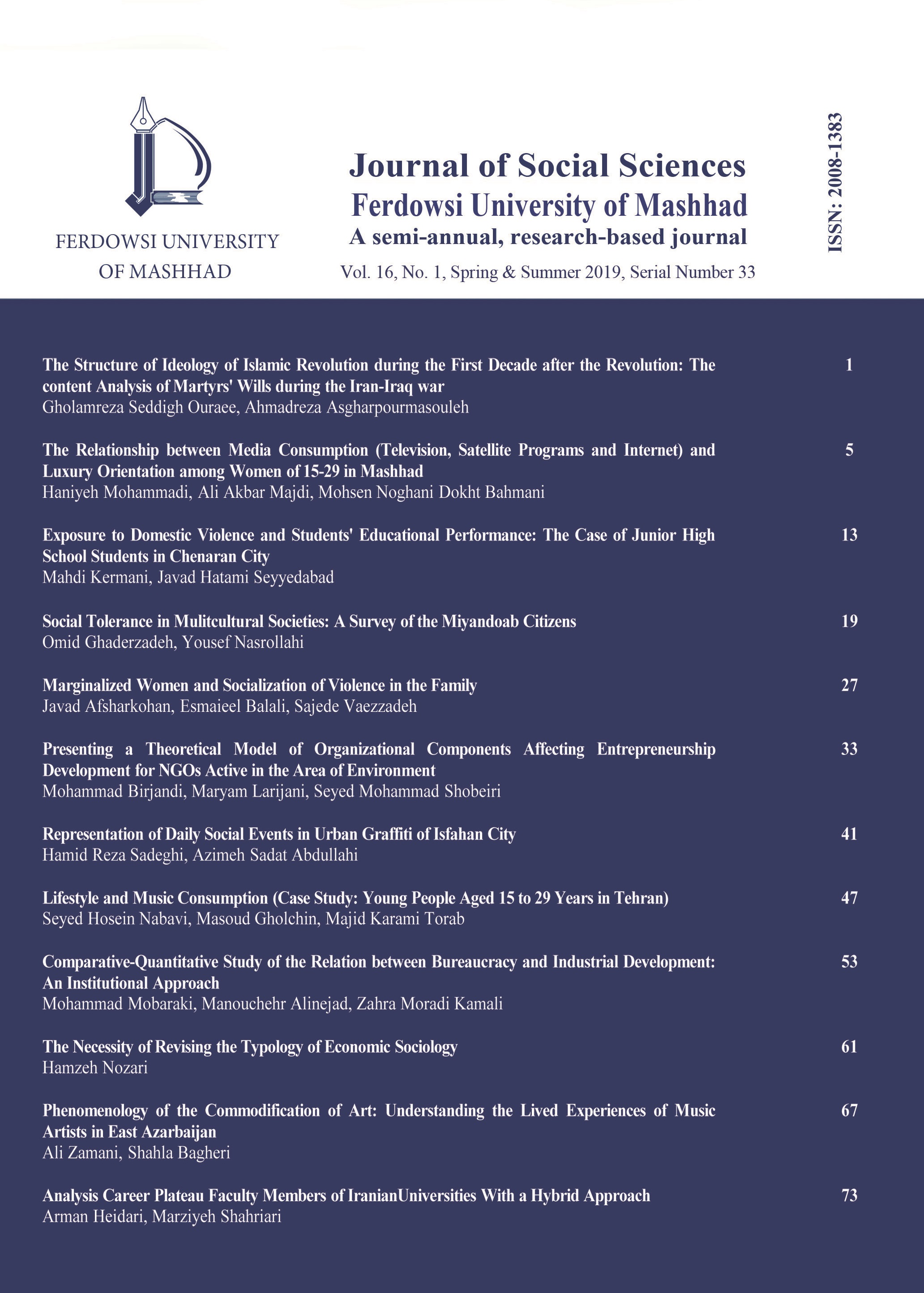Document Type : Scientific-Research
Authors
Payame Noor University Tehran
Abstract
Extended Abstract
Introduction
Graffiti is a new form of popular art which is particularly taken into consideration in terms of its association with micro-cultures, the youth, and street arts in metropolitan cities. Graffiti is also considered as way through which various communities express their beliefs and views. Essentially, graffiti is an action within the urban environment. Urban life is regarded as the birthplace of many artistic, musical, and cultural movements which is not coincidence. Undoubtedly, graffiti is an interaction between the artist and the city; the graffiti artist takes something from the city and would, in turn, add something else to it.
In Iran, common forms of graffiti date back to a long time ago, nearly equal to that of modern urbanization. Contrary to the past, the new function of graffiti in Iran is more closely associated with its critical, micro-cultural application. In fact, graffiti in Iran can be considered as a type of resistance logic that responds critically to social events. Graffiti does not react indifferently to social events that unfold daily throughout urban communities and assumes certain stances. The present study is an investigation of how daily social events are represented by graffiti in Isfahan city; moreover, it is attempted to indicate the explicit or implicit meanings behind such representations.
Review of Literature
There are two completely different views with respect to graffiti; On one hand, graffiti is regarded as a form of popular street art that can reflect daily critical and protest-related themes. On the other hand, it is considered as a criminal action in which the symbolic realm of cities is violated. In this study, the former view is the theoretical hypothesis; accordingly, graffiti is a form of popular street art that reflects social, political, and cultural themes, while such a process as well as the nature of representation can influence the real social life of citizens. As pointed out by Hal (2007), representation is essentially an ideological action present in power relations. Conflicts between different levels of power and ideologies could well be observed in such representations, particularly in the reflection of daily life in graffiti.
On one side, there is a power with a legal-urban nature that regards graffiti as a crime and prevents its realization; yet on the other side, there is an artistic-social power which considers graffiti as a popular art and attempts to oppose the legal-urban power. Such clashes are present in a more encrypted manner in graffiti itself along with a set of related represented themes. Nevertheless, according to Hal (2007), the essence of representation is ideological at its core and is related to power. Alternatively, representation highlights the relations among language, meaning, and culture. Through this perspective, graffiti can be regarded as a social action that enters power and ideology relations as a meaningful and cultural aspect that makes use of linguistic codes.
Method
The method used in this study is content analysis. Content analysis is a method for identifying, analyzing, and reporting the patterns existing within qualitative data. The total population of the study included the entire works of graffiti across Isfahan city since 2014 until 2018, designed by Isfahani graffiti artists. Overall, 9 works of graffiti was selected for analysis based on purposive sampling method. The obtained visual data were analyzed using semiotic analysis method, and particularly the mythical analysis put forth by Roland Barthes; in this method, images are analyzed at two levels including the linguistic level followed by the mythical level.
Results and Discussion
Given the analysis of the results obtained from the semiotic analyses of the selected graffiti, 8 main themes can be recognized in the context of the representation of daily events and social issues in graffiti. These social issues include economic corruption and embezzlement, Low-quality automobiles and deaths, virtualized demonstration of “self”, violence against women, demise of nature and destruction of communities, exposure of childhood to danger, materialization of knowledge, and cultural gestures.
In addition to their critical stances, graffiti in Isfahan also offer identity-building meanings; such meanings can be investigated through two dimensions. First, it can be expressed that graffiti is transforming into a meaningful action for certain sections of the urban population of Isfahan. Many graffiti artists and citizens have a sense of meaning through the presence of such works. In fact, the “wall” has become a space to seek identity-related meanings. Britney (2010) also believes that for graffiti artists, the “wall” has become a field to make social communications and be present in the public area. Through a similar outlook, Campus (2013) concluded that graffiti for the youth acts as a complex strategy intended for managing identity and daily life. The second aspect is the integration of identity that is formed through works of graffiti in Isfahan. This confirms the findings of certain Iranian inquiries such as Jamali (2013).
Conclusion
It can be concluded that the conflict between legal-urban institutions and artistic-social power in Isfahan city which appear to be more intense compared to those of other Iranian cities has left little space to design and implement the art of graffiti in Isfahan. However, the representation of issues and themes can be observed in works of graffiti across Isfahan city which are of a critical, protesting stance against certain social issues and at the same time are in line with solidarity with important, daily social events of Isfahan which somehow contributes to social integration. As a result, given the fact that graffiti in Isfahan is transforming into a source of identity building, particularly among teenagers and young adults, urban managers should not overlook their alarming or integrating messages. Problems and issues conveyed through urban graffiti should be recognized, reread, and analyzed so as to ensure a safe space were pressures, boredom, and potential protests concealed under the skin of the city can be expressed.
Keywords

Send comment about this article